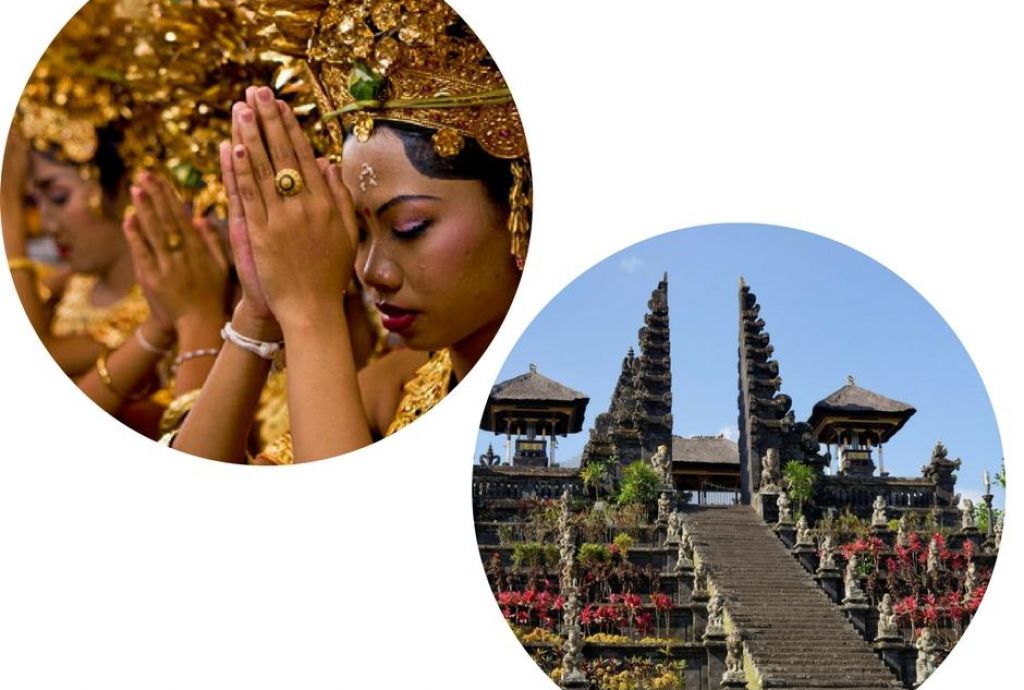
Hinduism religion

When people are thinking about Bali, they usually think about the famous and amazing landscapes: endless rice fields, beautiful beaches of white sand, amazing surf spots, huge temples, mountains and a lot of arts frequently performed by Balinese people: and so on.
Bali is a destination that has so much to offer if you try to discover its culture deeper. It is a place where you can combine every pleasure while discovering an extraordinary culture and the value of human kindness that no one can imagine.
The main characteristic of Balinese people is the art to combine discretion and curiosity over people they meet. Foreigners are really well-welcomed by the local population who are exceptionally warm and respectful. This kindness is due to the influence of their religious culture which is an important part of their daily habits. The religion is very important for most of the Balinese people, they are really diligent with all the daily offerings and ceremonies reported on their religious schedule. That can explain why the island is called “The Island of Gods”: religion is everywhere, visible in the streets and anchored in daily life.
The Balinese Hindu religion is not quite the same as the one in India. In Bali, this religion is adapted and inspired by the influence of the ancient indigenous beliefs. In the traditional villages called “Bali Aga”, this indigenous tradition is more existing. The religion keeps close links with nature and the forebears. Each element (tree, forest, rice field…) is the property of a spirit, honored by an altar where many offerings are given.
Each village has 3 temples, one dedicated to the forebears, one dedicated to the death that keeps the cemetery, and the last one called “Pura Desa” which is the spiritual heart of the village. In total, Bali counts no less than 5617 temples.
In each temple, you could notice a fabric with black and white tiles that decorate the statues. For Balinese Hinduism, the world is a place where good and evil live together, a balance between these two is important. This fabric is the symbol of this balance, it progressively becomes grey with the junction of the two colors.
Topic Categories
- All 280
- Uncategorized 6
- Bali Villa 20
- Bali Politics 6
- Bali News Update 7
- Bali Shopping 3
- Bali Tourism 34
- Bali Spirituality 2
- Bali Beauty and Fashion 0
- Bali History and Culture 23
- Bali Property Appraisal 1
- Bali Property Financing 3
- Bali Property Insurance 1
- Bali Property Management 5
- Bali Environment 10
- Bali Pets 2
- Bali Health and Wellness 6
- Invest in Bali 20
- Bali Local Services 5
- Bali Food & Dining 8
- Bali Home Improvement & Design 6
- Bali Legal Tips 7
- Bali Neighborhood Guides 11
- Bali Property Market Trends 13
- Bali Property Advice 56
- Bali Attractions 12
- FAQ 2
- Living in Bali 29
Topic Tags
- All 280
- Uncategorized 36
- Bali market report 1
- Villa for sale Canggu 4
- Villa for sale Uluwatu 4
- Bali Rentals 1
- Buying Process 6
- Labuan Bajo 0
- Bali Hospital 3
- Bali School 3
- Bali Beach 7
- Co-working Space 3
- Petitenget 1
- Australia 0
- China 2
- Bali Wedding 1
- Bali Flights 4
- Retire in Bali 4
- Nyepi 2
- Bali Villa Sale 18
- Bali Visa 4
- Bali Travel 23
- Villa Rental 7
- Airbnb 0
- PT PMA 3
- Bali Zoning Law 1
- Bali Tax 3
- Bali Property 50
- Double Six 0
- Sunset Road 0
- Nyanyi 1
- Legian 1
- Beach Club 4
- Oberoi 0
- Batu Bolong 3
- Batu Belig 0
- Business 2
- Legal 10
- Investment 31
- Tourism 44
- Travel 12
- Jimbaran 4
- Denpasar 2
- Seseh 2
- Eid al Adha 1
- Ascension Day 0
- Easter 0
- Vesak 0
- Islamic New Year 0
- Eid al-Fitr 1
- International Labor Day 0
- Independence Day 2
- Day of Silence 0
- Galungan Day 1
- Valentine 2
- Christmas 4
- New Year 4
- Lunar New Year 2
- Bali Market Trends 12
- Bali Art & Culture 18
- Bali Home Design 9
- Bali Health & Wellness 6
- Bali Food and Dining 10
- Bali Pets 3
- Bali Lifestyle 25
- Rice Field Front 1
- Jungle View 1
- River Front 0
- Rice Field View 3
- Ocean View 4
- Private Pool 0
- Fix and Flip 1
- Fixer-Upper 0
- Hotel & Resort 1
- Guest House 0
- Street Front 0
- Residential Zone 0
- Touristic Zoning 0
- Freehold 4
- Long Lease 7
- Short-Term 1
- Minimalist Villa 0
- Luxury Villa 7
- Turnkey Villa 3
- Residential Complex 0
- Exclusive Listing 0
- Off-Plan Property 4
- Studio 0
- Loft 0
- Apartment 8
- Villa 15
- Land 6
- Beachfront 3
- Family Villa 0
- Retirement Villa 1
- Investment Villa 22
- Digital Nomad 0
- Commercial Property 3
- Eco-friendly 0
- Contemporary Style 0
- Modern Style 1
- Javanese Style 0
- Rustic Style 0
- Traditional Style 0
- Bohemian Style 0
- Mediterranean Style 1
- Balinese style 1
- Nusa Penida 1
- Lombok 2
- Gili Island 3
- Amed 0
- Tabanan 1
- Cemagi 4
- Nusa Dua 6
- Sanur 4
- Umalas 4
- Berawa 5
- Ubud 3
- Tanah Lot 1
- Kuta 4
- Pererenan 5
- Uluwatu/Bukit Peninsula 15
- Seminyak 5
- Canggu 25
Relevant Articles you may like
About Bali Home Immo
Established in 2009, Bali Home Immo is the first real estate agency in Canggu with more than 7000 Bali properties listed in its database. Bali Home Immo (PT. Bali Properti Kontruksi) is a licensed property agency (SIUP-P4 certified) located in Bali, Indonesia and have been successfully operating as a trustworthy and reputable real estate agency with more than 13 years of experience. Long-standing partnerships and a committed, dedicated team are the driving force behind the work that takes place every day at Bali Home Immo.
As a member of the Real Estate Broker Association of Indonesia (AREBI), Bali Home Immo Property offers luxury real estate across the region to a local and international client base. Catering to a wide range of property requests, the team will ensure they can find a property, land or residential listing, to match each client’s personal requirements.
We have curated a wide selection of properties ranging from the land for sale, villas for sale and rent, as well as commercial space rental in Bali's most in-demand areas including Canggu, Seminyak, Pererenan, Umalas, and Uluwatu. Not only Bali, but our connection also reaches other popular destinations in Indonesia including Gili Islands, Lombok, Labuan Bajo, and more.
We also provide professional marketing services that will showcase the best of your Bali properties to more than +160k social media followers and maximise the potential to find buyers looking at villas for sale in Bali. With a thorough knowledge of the Bali property market inside-out, we deliver the most professional and data-driven valuation of your property at the most competitive price for your Bali properties.
Our expertise in the local market and extensive network affiliated with 93 local and international partners including Goplaceit.com, Rumah123, Kangaloo, Luxury Estate, and many more will also help you bring global exposure to your real estate investment and find your dream Bali property. Looking to buy villas for sale in Bali? Check out our online catalogue of Bali real estate and follow us on social media for updates.
Map
Send an Enquiry
Property Search
Sell/Rent My Property
Please fill this form and our listing agents will contact you to visit your property and/or give you a price valuation






